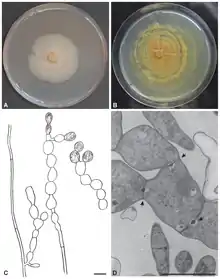| Serendipita | |
|---|---|
 | |
| Morphology of Serendipita herbamans: (A) Colony after two weeks of inoculation on MYP agar. (B) Colony after 6 months of inoculation on MYP agar. (C) Cylindrical and monilioid hyphae without clamps. Older monilioid hyphae become slightly yellow coloured. (D) Transmission electron micrographs showing monilioid hyphae with a septal porus at the constrictions (arrows). Scale bar C, D = 5 µm. | |
| Scientific classification | |
| Kingdom: | |
| Division: | |
| Class: | |
| Order: | |
| Family: | |
| Genus: | Serendipita P.Roberts (1993) |
| Type species | |
| Serendipita vermifera (Oberw.) P.Roberts (1993) | |
| Species | |
|
S. australiana | |
| Synonyms | |
|
Piriformospora | |
Serendipita is a fungal genus of the order Sebacinales. It was described in 1993 with Serendipita vermifera (originally Sebacina) as the type species.[1] In 2016, this genus was moved into its own family Serendipitaceae. [2]
References
- ↑ Roberts P. (1993). "Exidiopsis species from Devon, including the new segregate genera Ceratosebacina, Endoperplexa, Microsebacina, and Serendipita". Mycological Research. 97 (4): 467–78. doi:10.1016/S0953-7562(09)80135-4.
- ↑ Weiß, Michael; Waller, Frank; Zuccaro, Alga; Selosse, Marc‐André (July 2016). "Sebacinales – one thousand and one interactions with land plants". New Phytologist. 211 (1): 20–40. doi:10.1111/nph.13977.
External links
This article is issued from Wikipedia. The text is licensed under Creative Commons - Attribution - Sharealike. Additional terms may apply for the media files.